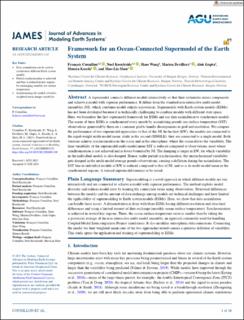| dc.contributor.author | Counillon, Francois Stephane | |
| dc.contributor.author | Keenlyside, Noel Sebastian | |
| dc.contributor.author | Wang, Shuo | |
| dc.contributor.author | Devilliers, Marion | |
| dc.contributor.author | Gupta, Alok Kumar | |
| dc.contributor.author | Koseki, Shunya | |
| dc.contributor.author | Shen, Mao-Lin | |
| dc.date.accessioned | 2023-06-29T09:45:50Z | |
| dc.date.available | 2023-06-29T09:45:50Z | |
| dc.date.created | 2023-04-13T17:45:33Z | |
| dc.date.issued | 2023 | |
| dc.identifier.issn | 1942-2466 | |
| dc.identifier.uri | https://hdl.handle.net/11250/3074320 | |
| dc.description.abstract | A supermodel connects different models interactively so that their systematic errors compensate and achieve a model with superior performance. It differs from the standard non-interactive multi-model ensembles (NI), which combines model outputs a-posteriori. Supermodels with Earth system models (ESMs) has not been developed because it is technically challenging to combine models with different state space. Here, we formulate the first supermodel framework for ESMs and use data assimilation to synchronise models. The ocean of three ESMs is synchronised every month by assimilating pseudo sea surface temperature (SST) observations generated by them on a common grid to handle discrepancies in grid and resolution. We compare the performance of two supermodel approaches to that of the NI. In the first (EW), the models are connected to the equal-weight multi-model mean, while in the second (SINGLE), they are connected to a single model. Both versions achieve synchronisation in the ocean and in the atmosphere, where the ocean drives the variability. The time variability of the supermodel multi-model mean SST is reduced compared to observations, most where synchronisation is not achieved and is lower-bounded by NI. The damping is larger in EW, for which variability in the individual models is also damped. Hence, under partial synchronisation, the unsynchronized variability gets damped in the multi-model average pseudo-observations, causing a deflation during the assimilation. The SST bias in individual models of EW is reduced compared to that of NI, and so is its multi-model mean in the synchronised regions. A trained supermodel remains to be tested. | en_US |
| dc.language.iso | eng | en_US |
| dc.publisher | American Geophysical Union | en_US |
| dc.rights | Navngivelse-Ikkekommersiell 4.0 Internasjonal | * |
| dc.rights.uri | http://creativecommons.org/licenses/by-nc/4.0/deed.no | * |
| dc.title | Framework for an Ocean-Connected Supermodel of the Earth System | en_US |
| dc.type | Journal article | en_US |
| dc.type | Peer reviewed | en_US |
| dc.description.version | publishedVersion | en_US |
| dc.rights.holder | Copyright 2023 the authors | en_US |
| dc.source.articlenumber | e2022MS003310 | en_US |
| cristin.ispublished | true | |
| cristin.fulltext | original | |
| cristin.qualitycode | 1 | |
| dc.identifier.doi | 10.1029/2022MS003310 | |
| dc.identifier.cristin | 2140696 | |
| dc.source.journal | Journal of Advances in Modeling Earth Systems | en_US |
| dc.identifier.citation | Journal of Advances in Modeling Earth Systems. 2023, 15 (3), e2022MS003310. | en_US |
| dc.source.volume | 15 | en_US |
| dc.source.issue | 3 | en_US |

